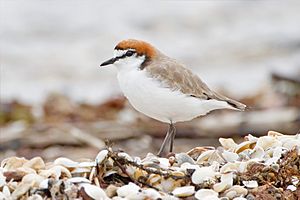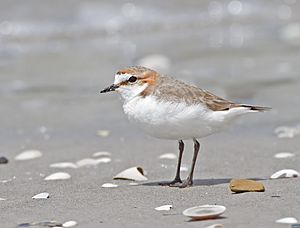Red-capped plover facts for kids
Quick facts for kids Red-capped plover |
|
|---|---|
 |
|
| Male in breeding plumage | |
 |
|
| Female in breeding plumage | |
| Conservation status | |
| Scientific classification | |
| Genus: |
Charadrius
|
| Species: |
ruficapillus
|
The red-capped plover (Charadrius ruficapillus), also known as the red-capped dotterel, is a small type of plover. These birds are found mostly in Australia. They are very similar to other plovers like the Kentish plover.
Contents
What Does a Red-Capped Plover Look Like?
Red-capped plovers have a white forehead and white underparts, which is their belly and chest. Their upper parts, like their back, are mostly grey-brown.
Differences Between Males and Females
Adult male plovers have a reddish-brown crown (the top of their head) and hindneck (the back of their neck). This reddish-brown color is called rufous.
Adult female plovers have a lighter reddish-brown and grey-brown crown and hindneck. They also have a light stripe near their eyes.
Size and Feathers
When a red-capped plover flies, you can see its dark brown flight feathers and a white bar on its wing. These birds are about 14–16 cm (5.5–6.3 in) long. Their wings can spread out to 27–34 cm (10.6–13.4 in) wide. They are quite light, weighing only about 35–40 g (1.2–1.4 oz).
Plumage Changes
A bird's plumage is its set of feathers. When red-capped plovers are ready to breed, their feathers look brighter. Their crown and the back of their neck become a richer red-brown with black edges. When they are not breeding, their feathers are duller and do not have the black edges.
Where Do Red-Capped Plovers Live?
The red-capped plover lives all over Australia. Sometimes, they visit New Zealand, and they even bred there in small numbers from 1950 to 1980.
Habitats They Prefer
These plovers live in many different places, both near the coast and inland. You can find them in areas like estuaries (where rivers meet the sea), bays, and sandy beaches. They also like mudflats and inland salty wetlands. They can also be found in other wet areas inland that have bare ground.
What Do Red-Capped Plovers Eat?
Red-capped plovers mainly eat small creatures without backbones. These include tiny molluscs, which are like snails or clams. They also eat crustaceans, such as small crabs or shrimp, and worms.
Reproduction and Life Cycle
Red-capped plovers living near the coast in Australia breed at certain times of the year. However, inland plovers breed when there is enough rain, which can be unpredictable.
Nesting Habits
These plovers build their nests on the ground, usually close to wetlands. Their nest is a small dip in the ground with very little or no soft lining. The female bird lays a clutch of two eggs. These eggs are pale yellowish-brown and have black spots.
Chicks and Incubation
The eggs take about 30 days to hatch. The female plover does most of the sitting on the eggs to keep them warm. When the chicks hatch, they are born with their eyes open and can move around quickly. They are called precocial because they are quite developed. They leave the nest soon after they hatch. This helps them avoid being found by predators like gulls and crows.
Conservation Status
The red-capped plover is not considered to be in danger. There are many of them, and their numbers are not going down. Because of this, their conservation status is listed as "Least Concern."
Images for kids
See also
 In Spanish: Chorlitejo capelirrojo para niños
In Spanish: Chorlitejo capelirrojo para niños





